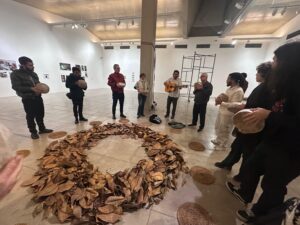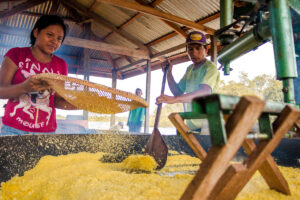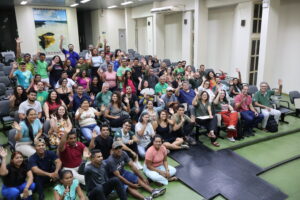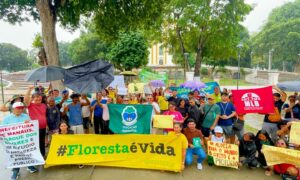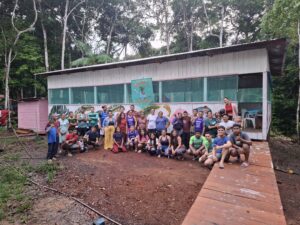On this April 19th, Indigenous Peoples’ Day, we reflect on the importance of marking our Well-Being by bringing the different perspectives of two peoples from the Mid Juruá Territory.
By: Phamela Barbosa, Indigenous woman in land reclamation, socio-environmental educator at Instituto Juruá
Raimundo Silva, Indigenist at CIMI and local coordinator for Instituto Juruá in Itamarati-AM
A quality and dignified life requires basic guarantees to be sustained. Health, food, housing, and knowledge are some of the essential elements we can name as fundamental to humanity’s Bem Viver—the Good Living. April brings into focus the struggles of Indigenous peoples: their resistance, their pain, and their tireless pursuit of the utopia of Bem Viver—a world where everyone has a voice and a place. A shared existence for all living beings, built on balance, justice, and dignity for all.
The discussion around Bem Viver emerged thanks to Latin American movements—mostly Indigenous movements—combined with growing disillusionment with the concept of development in the late 1990s. The practice of Bem Viver is grounded in the principle of harmonious balance in one’s relationship with oneself; between the individual and the community; and ultimately, between the person and the planet, along with all other beings. For thousands of years, Indigenous peoples have exemplified this practice with remarkable mastery, establishing a relationship of interdependence with nature based on deep respect. This stands in contrast to the colonial way of inhabiting the world, which invaded Abya Yala—now known as the American continent since 1492.
What history tells us—and what the traditional ways of Indigenous peoples clearly demonstrate—is that Indigenous peoples have lived on this land for thousands of years and have always known how to coexist with nature. Over millennia, they have maintained a relationship of belonging and care that, for the most part, non-Indigenous people are unable to fully understand, as they live within a system and hold a worldview that is entirely different—one in which everything is treated as a commodity, driven by individual profit rather than the common good. To prove this, we need only consider that five hundred years ago, before the Portuguese invasion, thousands of people from diverse nations lived in what is now Brazil. They had been here for centuries and kept nature—and all the resources it offers for sustaining life—protected. Today, a little over five centuries after that invasion, the native form of nature is nearly extinct across most of the national territory, with the largest preserved areas being those where Indigenous peoples continue to live.
“Territory is a branch that connects us to the root. It is a relationship with the sacred. Territory is our collective home, but it is also our inner home. With territory, the relationship is not with the land as matter: it is an ancestral relationship of body and spirit. Territory is land, water, wind, person, animal, plant, plateau, cave, tree, farm, but not only— it is everything that these things signify in the multiple potentials of the words, while simultaneously not fitting within them. In our bodies, this creation manifests in paintings, language, food, protection, affection, and ways of learning to teach. Our body-territories are fertile places for developing and preserving knowledge. We learn more from the living tree than from a dead paper. This is the knowledge of those who live and learn with the territory, this is the science of our people.” Concept of body-territory by Vicente, Edvaldo, and Celia Xakriabá.
For Indigenous peoples, the land is mother; it provides sustenance, shelter, knowledge, and the guarantee of our existence. But to do all of this, it requires care, and Indigenous peoples are the ones who most understand and maintain this care, as their lives depend on this exchange of care. They know that if they protect nature, it will continue to ensure life for them and for all that it can reach.
Photo: CIMI collection.
In order to better reflect on the well-being of Indigenous populations and the importance of keeping their territory alive, let’s learn a little about the reality of two Indigenous peoples living in the Juruá River region: the Deni people and the Kulina people. Mr. Edson Ferreira is one of the leaders of the Matatibem village, in the Kulina Indigenous land of the Uere River, in the municipality of Carauari-AM. This land is not yet demarcated and is currently in the demarcation process. “We are being disrespected, discriminated against in our home, which is our territory. People don’t respect it, they come and go as they please, bringing bad things and taking away our wealth. They say that our territory is not demarcated, so they can do whatever they want. We don’t want to fight with anyone, we just want our rights to be respected. We have the right to the exclusive use of our territory, and that right is not being respected. We can no longer make our handicrafts, our rituals, like we used to, because non-Indigenous people are in our land claiming ownership. They hunt in the forest to sell in the city, set traps in the woods, and our people cannot go get the materials we need because they fear being shot by those traps. The fish, the game for our food, and our traditional festivals are disappearing from our land because they are destroying everything. They take wood all year long to sell. We report it to FUNAI, ask the competent authorities to take action, but we see no results, and the excuse is that our land is not demarcated. This is disrespect to our lives. What will become of our lives and the lives of our children if they continue destroying our territory? What will we eat, where will we live? We live under threat, we have already lost relatives to the invaders, and justice does nothing. We don’t have the strength to defend our land because we are alone. The law doesn’t help us, the excuse is that our land is not demarcated. We have always been here, this land is ours, we need it to live. Without nature, our people cannot survive. What’s the point of existing if we don’t have our home? Nature is our home, the land is our mother, and they are not letting us take care of her. If we don’t take care of her, she will continue to die, and we will too.” This is the reality and the feeling of a people whose right to their land, their home, is not respected.
Mr. Vamuna Hava Deni, from the village of Morada Nova, on the Xeruã River, in Deni Indigenous Land, municipality of Itamarati, shares a bit of his story: “When I was young, we lived far from the city, from the communities, carivá* were in our land, and we moved far away out of fear. The boss made us work extracting solva*, but he never paid us, we would get rations, salt, ammunition, few things, and the boss always said there was no balance. We only worked, it was very bad, they didn’t let us plant crops, we had to buy flour from the boss. The life of Deni was hard. We caught many illnesses from the white man, there was no medicine, many Deni died— measles killed many of our people. In the Xeruã River, the fish were disappearing, many white people with big boats took away our fish, a lot of suffering those times. We wanted our land, and then we got the demarcation in 2003, the Deni demarcated our land, together with our partners—CIMI, OPAN, and Greenpeace—who brought FUNAI to demarcate our territory, then Deni began to care for our land. There are no more white men on our land. We organized our villages, planted our fields, and grew plenty of fruit for the children to eat, no longer let invaders take our fish, our game, our wood. Deni can take care of the land, today, our land is abundant—the fish have returned, the game is nearby, and our gardens are full of fruit. With our land demarcated, our people created an organization, we founded ASPODEX (Association of the Deni People of the Xeruã River), which represents our territory. We hold an annual assembly to decide together on surveillance, the organization of each village, and to strengthen our people so we don’t lose our land. We manage the pirarucu, we began managing it to protect our fish and care for our lakes. At first, we didn’t want to sell the pirarucu—our goal was to protect it so we’d always have it in our territory for our people—but after a few years we decided to harvest some, because now there are a lot of fish and we won’t go without food. Through management, we get resources for our assembly and to improve infrastructure in the villages. Before, I lost many Deni relatives, today, our land is healthy; there is a health team in the village, a health post, a school for Deni to learn—we even have Deni teachers. Life is much better now. Our people have food, homes, make traditional festivals, play soccer, have good igarapé for fishing. Carivá* don’t invade our land anymore, now we can care for our land. There’s no shortage of food—we can catch fish quickly, and the game is close by. I remember the suffering of the past, now the Deni live well, and our children can grow up and live better lives.” Beneath the veins of the same river, neighboring lands reflect two completely different realities in how people live and the quality of life they experience—all depending on whether or not they have the right to their territory. For Indigenous peoples, dignity begins with the land.
This month, from April 7 to 11, the 21st edition of the Free Land Camp (ATL) took place — the largest Indigenous mobilization in Brazil in defense of their territories and broader rights. “We Are the Answer,” a global campaign by the Indigenous movement, reinforces the essential role of land demarcation and Indigenous peoples in confronting the climate crisis. During the event, the Indigenous Nationally Determined Contribution (NDC) was launched, highlighting the need for equity, self-determination, and effective participation of Indigenous peoples and traditional communities in the implementation of Brazil’s national climate plan. In addition, a committee was created for the upcoming Conference of the Parties (COP-30), which will take place later this year in Belém, Pará, aiming to amplify the visibility and influence of Indigenous peoples in climate negotiations — a process that directly affects the lives of thousands of relatives across their territories.
One of the main struggles of Indigenous peoples is the guarantee of their territory, as all other rights will be better ensured from this: demarcating their Bem Viver. There is no well-being without the guarantee of territories, without the demarcation of lands that have always been Indigenous, extensions of our bodies. This Indigenous April, we reinforce what can no longer be ignored: DEMARCATION OF INDIGENOUS LANDS NOW! NO TO THE TIME LIMIT TRICK!
*Glossary:
Cariva = non-Indigenous person.
Solva = an Amazonian tree from which latex is extracted to mix with rubber tree latex to coagulate and make rubber sheets.
References:
https://apiboficial.org/2025/04/10/apib-lanca-ndc-indigena-e-comissao-internacional-para-cop-30/
https://www.scielo.sa.cr/scielo.php?script=sci_arttext&pid=S2215-24662017000200001

